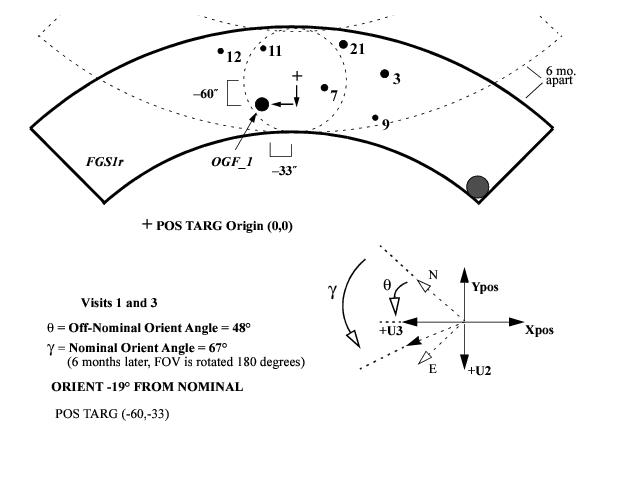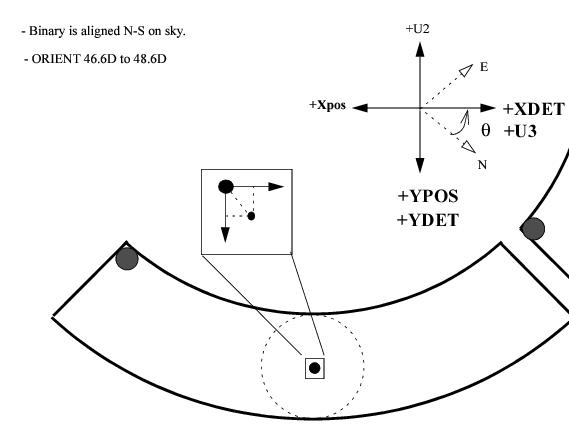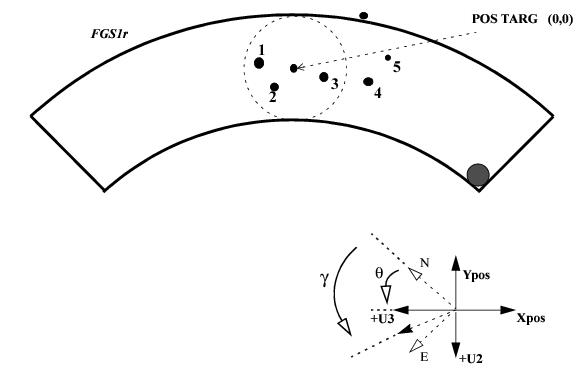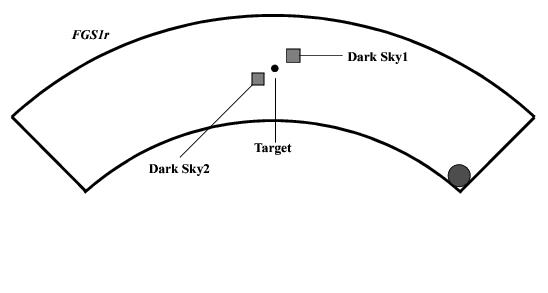6.5 Proposal Logsheet Examples
This section provides several examples of RPS2 formatted proposal logsheets for the following types of investigations:
- Parallax program using FGS1r in Pos mode
- Determining a binary’s orbital elements using FGS1r in Trans mode.
- Mass Determination: Trans and Pos mode
Faint binary with Trans mode: special background measurements.
While formatted exposure logsheets became obsolete when APT replaced RPS2, the logsheets provided here are intended to assist proposers in to obtain a high level understanding of an FGS observing program within a single HST orbit.
6.5.1 Parallax program using FGS1r in Pos mode
- Goal: Determine the parallax and proper motion of star, “OGF_1”.
- Scenario:
-The program requires three visits, at 0, 6, 12 months intervals, each of which is timed to occur at epochs of maximum parallax factors. During each visit the science target and reference stars will be observed multiple times in Pos mode.
-A special orientation is needed to align the FGS FOV so that the target and selected reference stars fall within the FOV (and hence are observable!). The appropriate Orient range can be determined by using special tools (e.g., PICKLES or VTT)
-Filter for all targets with V > 8: F583W.
-Reference Star Geometry: Six reference stars near science target; POS TARG required to fit all reference stars in the pickle. See Figure 6.1.
- Special Considerations:
-The need for special orientation must be explained in the text justification section.
-The science target must be shifted from FGS1r aperture reference point (center of FOV) in order to fit all (i.e., OGF-21-REF) stars in the FOV. Appropriate POS TARG can be determined from PICKLES or VTT. Contact STScI Help desk for assistance if necessary.
- Target Logsheet:
-See the HST Phase II Proposal Instructions for assistance.
-Please include color information on all targets if available so the need for color-related calibrations can be assessed by STScI.
Figure 6.1 illustrates the field geometry and the orient angles of a typical FGS observation, while Table 6.8 summarizes the details of the exposures in the visit.
Table 6.8: Target and Exposure Input for Example 1
Target | V | FILTER | FESTIME | Exposure Time | ~NEA |
|---|---|---|---|---|---|
“OGF_1”a | 9 | F583W | 0.025 | 20 | < 1.0 |
OGF-3-REFa | 11.1 | F583W | 0.025 | 20 | < 1.0 |
OGF-7-REF1 | 10.3 | F583W | 0.025 | 20 | < 1.0 |
OGF-9-REF | 10.2 | F583W | 0.025 | 20 | < 1.0 |
OGF-11-REFa | 13.3 | F583W | 0.050 | 30 | 3.1 |
OGF-12-REF | 13.6 | F583W | 0.050 | 30 | 3.5 |
OGF-21-REF | 11.5 | F583W | 0.025 | 20 | 1.0 |
1 The “REF” appendix is not required. Rather its use is suggested simply for book keeping purposes.
- Reference/Check Star Pattern: Check Stars in this observation are REF-7, REF-11, and OGF_1. Observing sequence:
OGF_1--> 12 -- 11 -- 7 -- OGF_1 -- 11 -- 21 -- 3 -- 7 -- OGF_1
-----> 9 -- 7 -- 11 -- OGF_1 -- 21 -- 12 -- 11 -- 9 -- OGF_1
- The Exposure Logsheet Template: The Optional_Parameters entry is missing since, for this example, all Pos mode optional parameters are DEFAULT values
Visit_Number: 1
Visit_Requirements: BETWEEN 14-MAR-1998 AND 15-MAR-1998
ORIENT -18.5D TO -19.5D FROM NOMINAL
Visit_Comments: Two Guide Star FineLock Required.Exposure_Number: 01
Target_Name: OGF_1
Config: FGS
Opmode: POS
Aperture: 1
Sp_Element: F583W
Time_Per_Exposure: 20S
Special_Requirements: SEQ 1-4 NON-INT;POS TARG -33,-60.
Exposure_Number: 02
Target_Name: OGF-12-REF
Config: FGS
Opmode: POS
Aperture: 1
Sp_Element: F583W
Time_Per_Exposure: 30S
Special_Requirements: SAME POS AS 1;
Exposure_Number: 03
Target_Name: OGF-11-REF
Config: FGS
Opmode: POS
Aperture: 1
Sp_Element: F583W
Time_Per_Exposure: 30S
Special_Requirements: SAME POS AS 1;
Comments:
Exposure_Number: 04
Target_Name: OGF-7-REF
Config: FGS
Opmode: POS
Aperture: 1
Sp_Element: F583W
Time_Per_Exposure: 20S
Special_Requirements: SAME POS AS 1;
Comments:
...and continues until the orbit is filled.
6-months after Visit 1, the HST Nominal Orient Angle is 180° from the Nominal HST Orientation in Visit 1. Nominal orient angle = 247°, off-nominal orient angle = 228°, pos targ = (+60,+33).
Visit_Number: 2
Visit_Requirements: BETWEEN 14-SEP-1998 AND 15-SEP-1998;
ORIENT -18.5D TO -19.5D FROM NOMINAL
Visit_Comments: Two Guide Star FineLock Required.
Exposure_Number: 01
Target_Name: OGF_1
Config: FGS
Opmode: POS
Aperture: PRIME
Sp_Element: F583W
Time_Per_Exposure: 20S
Special_Requirements: SEQ 1-4 NON-INT;POS TARG +33,+60
Comments:
Exposure_Number: 02
Target_Name: OGF-12-REF
Config: FGS
...Continues until the orbit is filled. Visit 3 is identical to Visit 1 except that it executes 1 year later.
Running the proposal template file through APT will inform the observer whether the syntax is correct, whether the exposures fit in an orbit and how much time is left, and finally whether the observing dates are viable for the requested ORIENT angle.
6.5.2 Determining a binary’s orbital elements using FGS1r in Trans mode
- Goal: Observe a known faint (V=16) close (separation ~40 mas) binary in Trans mode in order to determine the system’s relative orbit from which the orbital element, and hence, the system’s mass can be derived.
- Scenario:
-Program requires 4 single orbit visits to observe the binary at different orbital phases. These shall be timed accordingly.
-Target is faint enough (V>8) for filter F583W.
-The expected separation of binary is ~40 mas. Its position angle is expected to be approximately 180 deg at the time of the first planned observation. This will have implications for the ORIENT of HST for the visit (see below. Note that special orients also imply scheduling constraints. Use of APT will facilitate resolving these constraints.)
-Reference Star Geometry: Six reference stars near science target; POS TARG required to fit all reference stars in the pickle. See Table 6.1, Example 1: Field of View at Special Orientation.
- Special Considerations:
-Include B-V color information. STScI will use such information to plan the calibration observations of the color reference standard stars.
-ScanLength: 0.5 arcsec.
-The expected separation of binary is ~40 mas. Its position angle is expected to be approximately 180 deg at the time of the first planned observation. This will have implications for the ORIENT of HST for the visit (see below. Note that special orients also imply scheduling constraints. Use of APT will facilitate resolving these constraints.)
-Reference Star Geometry: Six reference stars near science target; POS TARG required to fit all reference stars in the pickle. See Table 6.1, Example 1: Field of View at Special Orientation.
- Exposure Time Calculation
-target magnitude = 16.0, use F583W
-An ORIENT range is used to avoid the binary’s projected separation along either of the FGS axis to be less than 20 mas (to assure an accurate determination of the system’s total projected separation and position angle.).
-StepSize: 0.6 mas.
-target visibility period: 58 Minutes.
-guide star acq and instrument overheads: ~12 min.
-available observing time: ~ 46 min.
-time (sec) per scan = 0.025 * [ScanLength/StepSize] + 12 = 33. (note, the 12 sec is the per scan overhead.)
-the number of scans that can fit in within this observing window is Nscans = 46*60/33 = 83
-exposure time = Nscans*0.025*[ScanLength/StepSize]=1730 sec. (note the scan’s overheads are not included in the user specified exposure time)
Figure 6.2 illustrates the geometry of the binary with respect to the POS TARG and detector reference frames.
- The Exposure Logsheet Template:
Visit_Number: 1
Visit_Requirements: ORIENT 46.6D TO 48.6D
Visit_Comments: Two Guide Star FineLock Required. Please notify Contact Scientist if two guide stars cannot be found.
Exposure_Number: 01
Target_Name: Close_Binary
Config: FGS
Opmode: TRANS
Aperture: 1
Sp_Element: F583W
Optional_Parameters: SCANS=83, STEP-SIZE=0.6
Time_Per_Exposure: 1729S
Special_Requirements:
Comment:
Visit_Number: 2
Visit_Requirements: AFTER 1 BY 30D TO 32D
ORIENT -24D TO -25D FROM NOMINAL
Visit_Comments: Two Guide Star FineLock Required.
Exposure_Number: 01
Target_Name: Close_Binary
Config: FGS
Opmode: TRANS
Aperture: 1
Sp_Element: F583W
Optional_Parameters: SCANS=83, STEP-SIZE=0.6
Number_of_Iterations: 1
Time_Per_Exposure: 1729S
Special_Requirements:
And similar Visits for 3 and 4.
Running the proposal template file through APT will inform the observer whether the syntax is correct, whether the exposures fit in an orbit and how much time is left if they do not; and finally, whether the observing dates are viable for the requested ORIENT angle.
6.5.3 Mass determination: Trans and Pos mode
- Goal: A bright (V=13), wide binary system (separation = 0.4") is to be observed with FGS1r. Pos mode observations of the binary and neighboring reference stars will be used to determine the binary’s parallax, proper motion, and barycenter. Trans mode observations will be used to establish the system’s relative orbit so that its orbital elements can be derived. Combining these data from several epochs will allow for a dynamical mass determination of the system’s components.
- Scenario:
-program requires two visits every six months for three years.
-reference star distribution: six reference stars near science target; science target must be placed at aperture reference position for Trans mode observations.
- Special Considerations:
-include B-V color information on all targets, if available, so STScI can determine the need for specific calibrations.
-target magnitude = 13.0, use F583W
-ScanLength: 1.6 arcsec.
-StepSize: 0.6mas.
-target visibility: 63 minutes.
-total Trans mode exposure time: 28 minutes.
-exposure time calculation:
Texposure = 0.025 * [ScanLength/StepSize] * Nscans
where in this example ScanLength = 1.6 arcsec, StepSize = 0.0006 arcsec, and the number of scans Nscans = 25
Figure 6.3 illustrates the geometry of the target and reference stars, while Table 6.9 and Table 6.10 summarize the details of the exposures in the visit.
Table 6.9: Target and Exposure Input for Example 3
Target | V | FESTIME (use defaults) | FILTER | Total Exposure | ~NEA |
|---|---|---|---|---|---|
Wide_Binary1 | 13.0 | 0.050 | F583W | 20 sec | 2.0 |
Wide_binary | 13.0 | 0.025 | F583W | 28 min | σSx = 0.008 |
BL-1-REF2 | 10.8 | 0.025 | F583W | 20 sec | <1.0 |
BL-2-REF | 14.1 | 0.100 | F583W | 35 sec | 5.0 |
BL-3-REF | 11.5 | 0.025 | F583W | 20 sec | 1.0 |
BL-4-REF | 12.5 | 0.025 | F583W | 20 sec | 1.7 |
BL-5-REF | 13.0 | 0.050 | F583W | 20 sec | 2.5 |
1 The primary target needs only be listed once in the fixed target list.
2 The “REF” appendix is not required. Rather its use is suggest simply for book keeping purposes.
Table 6.10: Reference/Check Star Pattern
Mode | Overhead + Exposure Time (Minutes) |
|---|---|
GS ACQ + Instrumental Overheads. | 12 |
Trans mode
| 28 |
Pos mode:
| 2 |
6.5.4 Faint binary with Trans mode: special background measurements
- Goal: A faint (V=15) object suspected to be a close (sep < 30 mas) binary is embedded in nebulosity which contributes about 20% of the light in the vicinity of the target. The putative binary is to be observed in Trans mode. Special additional observations are needed accurately measure the background. To do so, the RA,Dec of two points on the sky about 1 arcmin from the target and to either side of it are specified as “targets” in the proposal. These “targets” are to be observed in Pos mode after the Trans mode observation of the faint science target (the FGS high voltage, which enable the PMTs to count photons, does not get turned on until after the IFOV is placed at the expected location of the first target to be observed in the visit. The background data is to be acquired as the IFOV slews away from the science object to the reference “targets”. During this time the PMTs record the background counts.)
- Scenario:
-Program requires a single one orbit visit.
-Target Filter: F583W.
-Reference Star Filter: F583W.
-Geometry: Science target is placed at center of the FGS1r FOV; the background data are obtained en route to and while observing the reference points (specified in the proposal as a pointed targets) in Pos mode for 1 minute.
- Exposure Time Calculation
-target magnitude = 15.0, use F583W
-target visibility period: 54 minutes..
-GS acq and instrumental setup time: 12 min.
-available observing time: 42 min.
-ScanLength: 0.5 arcsec.
-StepSize: 0.6 mas.
-time per scan = 0.025 * (0.5/0.0006) + 12 = 33 sec
-time for two Pos mode observations (include overheads): 3 min.
-approximate number of scans that can fit within orbit: 69
Figure 6.4 illustrates a possible geometry of the field, while Table 6.11 summarizes the total exposure times for the target and reference star, and dark sky observations.
Table 6.11: Target and Exposure Input for Example 4
Target | V | FILTER | Total Exposure |
|---|---|---|---|
HDFAINT | 15 | F583W | 39 min. |
Dark_Sky1 | 10 | F583W | 1 min. |
Dark_Sky2 | 12 | F583W | 30 S |
Specify the background targets to be bright (V=8) to minimize target acquisition overheads. Note: these targets will fail to be acquired in FineLock since no coherent source is present. However, the desired photometry will be recorded.
- Exposure Logsheet Template:
Visit_Number: 1
Visit_Requirements:
Visit_Comments:
Exposure_Number: 01
Target_Name: HDFAINT
Config: FGS
Opmode: TRANS
Aperture: 1
Sp_Element: F583W
Optional_Parameters: SCANS=69, STEP-SIZE=0.6
Time_Per_Exposure: 1380S
Special_Requirements: POS TARG = 0,0 SEQ 1-3 NON-INT
Exposure_Number: 02
Target_Name: DARK_SKY1
Config: FGS
Opmode: POS
Aperture: 1
Sp_Element: F583W
Optional_Parameters:
Time_Per_Exposure: 60 S
Special_Requirements: SAME POS AS 1
Exposure_Number: 03
Target_Name: DARK_SKY2
Config: FGS
Opmode: POS
Aperture: 1
Sp_Element: F583W
Optional_Parameters:
Time_Per_Exposure: 60 S
Special_Requirements: SAME POS AS 01



